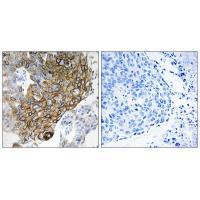
| WB | 咨询技术 | Human,Mouse,Rat |
| IF | 咨询技术 | Human,Mouse,Rat |
| IHC | 1/50-1/100 | Human,Mouse,Rat |
| ICC | 技术咨询 | Human,Mouse,Rat |
| FCM | 咨询技术 | Human,Mouse,Rat |
| Elisa | 咨询技术 | Human,Mouse,Rat |
| Aliases | Gap junction alpha-3 protein; Connexin-46; Cx46; |
| Entrez GeneID | 2700; |
| WB Predicted band size | 47kDa |
| Host/Isotype | Rabbit IgG |
| Antibody Type | Primary antibody |
| Storage | Store at 4°C short term. Aliquot and store at -20°C long term. Avoid freeze/thaw cycles. |
| Species Reactivity | Human,Mouse |
| Immunogen | Synthesized peptide derived from internal of human GJA3. |
| Formulation | Purified antibody in PBS with 0.05% sodium azide. |
+ +
以下是关于GJA3抗体的3篇参考文献,包括文献名称、作者和摘要内容概括:
1. **《Connexin 46 (GJA3) mutations associated with congenital cataract in a Chinese cohort》**
- 作者:Xia, C. H., et al.
- 摘要:研究通过基因测序筛查中国先天性白内障患者,发现GJA3(Connexin 46)基因的多个突变位点。利用GJA3特异性抗体进行免疫组化分析,证实突变导致蛋白在晶状体中的错误定位,破坏细胞间连接功能,进而引发白内障。
2. **《Aberrant GJA3/Cx46 interaction with lens-specific proteins causes autosomal dominant cataracts》**
- 作者:Shi, Q., et al.
- 摘要:研究使用GJA3抗体进行免疫共沉淀和Western blot,发现突变型GJA3蛋白与晶状体特异性伴侣蛋白(如αA-crystallin)结合异常,导致蛋白聚集和晶状体浑浊,揭示了显性遗传白内障的分子机制。
3. **《Functional characterization of GJA3 mutations in zebrafish models of cataract》**
- 作者:Park, J. E., et al.
- 摘要:通过在斑马鱼模型中过表达人源突变GJA3基因,结合抗体标记和活体成像技术,发现突变导致间隙连接功能受损及晶状体纤维细胞凋亡,为GJA3相关白内障的病理机制提供了体内实验证据。
4. **《Altered subcellular localization of GJA3 in age-related nuclear cataracts》**
- 作者:Wang, K. J., et al.
- 摘要:利用GJA3抗体对老年性核性白内障患者的晶状体样本进行免疫荧光分析,发现GJA3蛋白从细胞膜向胞质异常聚集,与氧化应激损伤相关,提示其亚细胞定位改变可能是白内障发展的关键因素。
The GJA3 antibody targets the Gap Junction Alpha-3 protein (GJA3), also known as Connexin 46 (Cx46), a member of the connexin family that forms gap junctions. These intercellular channels facilitate the exchange of ions, metabolites, and signaling molecules between adjacent cells, critical for maintaining tissue homeostasis. GJA3 is predominantly expressed in the lens of the eye, where it plays a vital role in lens transparency and fiber cell differentiation. Mutations in the GJA3 gene are linked to congenital cataracts, highlighting its importance in ocular development and function.
Antibodies against GJA3 are essential tools in studying its expression, localization, and functional roles in both physiological and pathological contexts. Researchers use these antibodies in techniques like immunohistochemistry, Western blotting, and immunofluorescence to investigate GJA3's involvement in lens biology, cataractogenesis, and cell-cell communication disorders. Additionally, GJA3 antibodies aid in exploring potential therapeutic strategies for cataracts and other connexin-related diseases. Their specificity and reliability are validated through controls like knockout models or peptide blocking assays. Understanding GJA3's mechanisms through antibody-based research contributes to broader insights into gap junction biology and ocular pathologies.
×